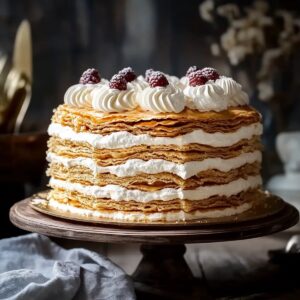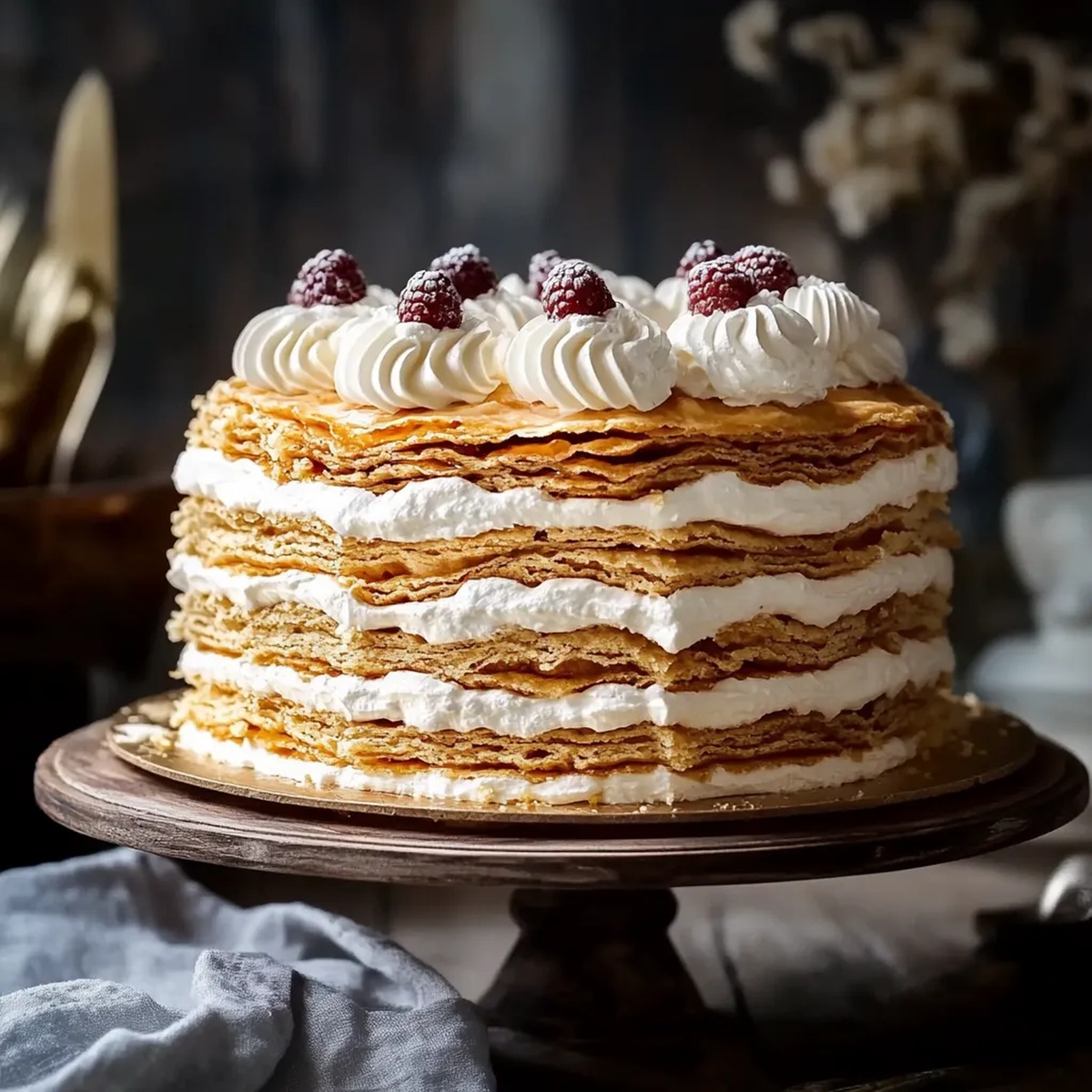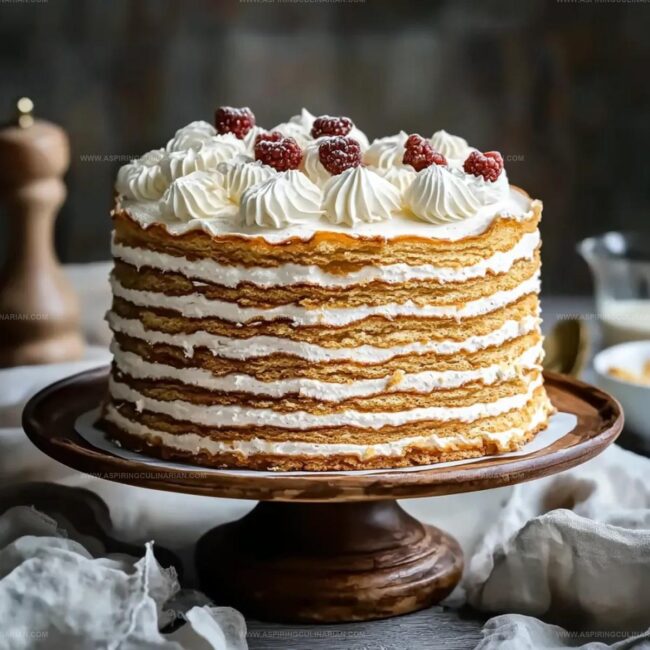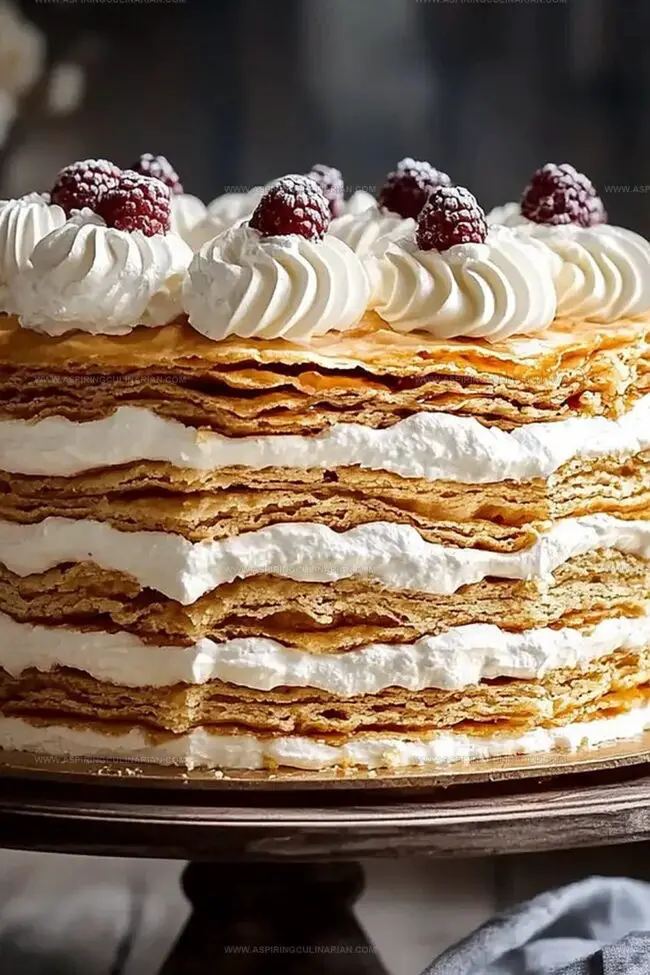The Best Argentinian Rogel Cake Recipe for Sweet Tooths
Sweet layers of dulce de leche and delicate meringue define this classic Argentinian rogel cake recipe that melts in your mouth.
Crisp, thin pastry discs stack into a towering masterpiece of creamy indulgence.
Each bite promises a symphony of textures and rich caramel notes.
Argentinian bakers have perfected this delightful dessert over generations.
Soft meringue sheets create a light yet decadent experience that surprises and delights.
Home cooks can easily recreate this elegant treat with a few simple techniques.
Prepare to impress your guests with a dessert that celebrates the sweet traditions of Argentina.
Argentinian Rogel Cake Special Features
Argentinian Rogel Cake What You’ll Need
Cake Base:Filling and Topping:Optional Finishing:Argentinian Rogel Cake How to Make It
Step 1: Prepare Flaky Base
Combine egg yolks, flour, and milk using a stand mixer with a hook attachment.
Mix until no liquid remains visible.
Gradually incorporate softened butter, continuing to knead until the dough becomes completely uniform and smooth.
Step 2: Shape and Chill Dough
Transfer dough to a clean countertop and hand-knead until perfectly smooth.
Wrap in parchment paper and refrigerate for two hours, allowing the gluten to relax and develop flavor.
Step 3: Create Delicate Layers
Preheat the oven to 390°F.
Divide chilled dough into 12 equal portions.
Roll each piece into thin, delicate rounds measuring 8-9 inches in diameter.
Keep unused dough covered to prevent drying.
Step 4: Prepare Baking Process
Carefully prick each dough round with a fork to prevent air bubbles.
Bake individual layers for approximately 7 minutes until they reach a light golden color.
Transfer gently to a wire rack, handling with extreme care as the layers are extremely fragile.
Step 5: Craft Swiss Meringue
Separate egg whites and let them sit at room temperature overnight to stabilize.
Create a water bath and combine egg whites with powdered sugar.
Gently warm while whisking, ensuring sugar dissolves completely.
If using a thermometer, heat to 131-140°F.
Step 6: Whip Meringue to Perfection
Transfer mixture to a stand mixer and whisk at medium speed until completely cooled.
The meringue should form soft, billowy peaks that hold their shape beautifully.
Step 7: Begin Cake Assembly
Place first pastry disc on a serving plate.
Spread a generous layer of dulce de leche across the entire surface, ensuring complete coverage.
Layer subsequent discs, alternating between pastry and dulce de leche.
Step 8: Complete Layering Technique
Continue stacking layers, carefully placing each disc and spreading dulce de leche.
Slight cracks are acceptable and will be hidden by the sweet filling.
Ensure the final layer is a pastry disc.
Step 9: Rest and Set Cake
Refrigerate the assembled cake overnight.
This resting period allows flavors to meld and the cake’s structure to stabilize and set perfectly.
Step 10: Final Decorative Touch
Lovingly cover the entire cake with prepared swiss meringue.
Create elegant, decorative peaks if desired, transforming the cake into a stunning culinary masterpiece.
Tricks for Argentinian Rogel Cake Perfection
Argentinian Rogel Cake Flavor Experiments
Serving Argentinian Rogel Cake with Style
Sweet Symphony of Serving:Storage for Argentinian Rogel Cake Made Easy
FAQs
Rogel Cake is a classic Argentine dessert that originated from European immigrant baking traditions, particularly influenced by Italian and French pastry techniques.
While the recipe requires patience and precision, home bakers with intermediate skills can successfully create this impressive layered dessert by following each step carefully.
Resting egg whites at room temperature helps stabilize them, making them easier to whip and creating a more stable, smoother swiss meringue with better volume and texture.
Yes, store-bought dulce de leche works perfectly fine. However, homemade dulce de leche can provide a richer, more authentic flavor if you have the time to prepare it.
Print
Argentinian Rogel Cake Recipe
- Total Time: 3 hours 7 minutes
- Yield: 12 1x
Description
Layers of delicate meringue and dulce de leche come together in this irresistible Argentinian Rogel Cake, creating a heavenly dessert that celebrates South American culinary artistry. Crisp, airy discs stacked with rich caramel promise a sublime experience you won’t soon forget.
Ingredients
Main Ingredients:
- 350 grams (12.3 ounces) all-purpose flour
- 6 egg yolks
- 1 kilogram (2.2 pounds) dulce de leche
- 400 grams (14.1 ounces) powdered sugar
- 220 grams (7.7 ounces) egg whites
Dairy and Liquid Ingredients:
- 100 grams (3.5 ounces) softened butter
- 60 milliliters (2 fluid ounces) milk
Preparatory Ingredients:
- None
Instructions
- Prepare the flaky dough by combining egg yolks, flour, and milk using a stand mixer’s hook attachment until fully incorporated.
- Add softened butter and continue mixing until the dough becomes uniform and cohesive.
- Transfer dough to the countertop and knead manually until smooth and elastic.
- Wrap the dough in parchment paper and refrigerate for 2 hours to relax the gluten structure.
- Preheat the oven to 200°C, ensuring even temperature distribution.
- Divide the chilled dough into 12 equal portions, keeping unused pieces covered to prevent drying.
- Roll each portion into thin, delicate rounds measuring 20-22 cm in diameter.
- Gently prick each round with a fork to prevent air bubble formation during baking.
- Bake each layer for 7 minutes until achieving a light golden color, carefully transferring to a wire rack to cool.
- Separate egg whites, leaving them at room temperature overnight to stabilize.
- Create swiss meringue by warming egg whites and powdered sugar over a water bath, whisking gently until sugar dissolves completely (55-60°C).
- Transfer the heated mixture to a stand mixer and whip at medium speed until cooled and soft peaks form.
- Begin cake assembly by placing the first pastry disc on a serving plate.
- Spread a generous layer of dulce de leche evenly across the first disc, ensuring complete coverage.
- Carefully position the next pastry disc, repeating the layering process with dulce de leche.
- Continue alternating layers, using all pastry discs and finishing with a pastry layer on top.
- Refrigerate the assembled cake overnight to enhance flavor integration and structural stability.
- Apply the prepared swiss meringue over the entire cake, creating decorative peaks for an elegant finish.
Notes
- Gluten-Free Adaptation Swap wheat flour with a blend of gluten-free alternatives like almond or rice flour to accommodate dietary restrictions.
- Meringue Stability Ensure egg whites are at room temperature and use a clean, grease-free bowl to achieve maximum volume and stability during whipping.
- Precision Matters Use a kitchen scale for exact measurements, especially when portioning dough layers to guarantee uniform thickness and consistent baking.
- Storage Secrets Store the finished Rogel cake in an airtight container in the refrigerator for up to three days, allowing the flavors to develop and intensify.
- Prep Time: 3 hours
- Cook Time: 7 minutes
- Category: Desserts
- Method: Baking
- Cuisine: Argentinian
Nutrition
- Serving Size: 12
- Calories: 338
- Sugar: 35 g
- Sodium: 36 mg
- Fat: 17 g
- Saturated Fat: 10 g
- Unsaturated Fat: 7 g
- Trans Fat: 0 g
- Carbohydrates: 44 g
- Fiber: 0 g
- Protein: 6 g
- Cholesterol: 80 mg






Lena Martinez
Contributing Writer & Culinary Educator
Expertise
Southwestern and Latin American cuisines, Vegetarian and plant-based recipe development, Culinary education and community outreach
Education
Santa Fe Community College, Santa Fe, NM
Certificate in Culinary Arts
Emphasized Southwestern cuisine and sustainable cooking practices
Lena grew up surrounded by the colors, spices, and traditions of the Southwest – flavors that sparked her love for bold, honest cooking. After earning her Culinary Arts certificate at Santa Fe Community College, she made it her mission to teach home cooks how to create flavorful, plant-powered meals without the fuss.
Her recipes are packed with vibrant ingredients, simple steps, and the kind of heart that turns a regular meal into something you’ll want to share. Outside the kitchen, Lena spends her time wandering farmers’ markets, trading family recipes, and helping young chefs find their voice through food.